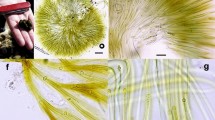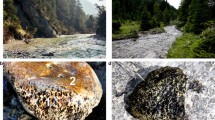Abstract
Relationships among dinoflagellates of the genus Alexandrium (=Protogonyaulax) from Long Island, New England, USA, and northeastern Canada were investigated between 1983 and 1987 using enzyme electrophoresis. A relative lack of heterogeneity among toxic isolates was observed despite large geographic separations of source populations. This observation is in marked contrast to observations on toxic members of this genus from the west coast of Canada and the United States. These different enzyme variability patterns support the proposal that dispersal of toxic strains in the east from a common source has occurred recently, presumably from established populations in northern Maine, USA, or Canada. Non-toxic strains from the study area were only distantly related to toxic isolates, consistent with their different morphology and separate species designations. One non-toxic isolate from a different region, that is conspecific with a number of the toxic strains, was more similar to these isolates than to other non-toxic clones.
Similar content being viewed by others
Literature cited
Alam, M. I., Hsu, C. P., Shimizu, Y. (1979). Comparison of toxins in three isolates of Gonyaulax tamarensis (Dinophyceae). J. Phycol. 15: 106–110
Anderson, D. M., Jacobson, D. M., Bravo, I., Wrenn, J. H. (1988). The unique microreticulate cyst of the naked dinoflagellate Gymnodinium catenatum. J. Phycol. 24: 255–262
Anderson, D. M., Kulis, D. M., Orphanos, J. A., Ceurvels, A. R. (1982). Distribution of the toxic red tide dinoflagellate Gonyaulax tamarensis in the southern New England region. Estuar. cstl Shelf Sci. 14: 447–458
Anderson, D. M., Morel, F. M. M. (1979). The seeding of two red tide blooms by the germination of benthic Gonyaulax tamarensis hypnocysts. Estuar. cstl mar. Sci. 8: 279–293
Anderson, D. M., Wall, D. (1978). The potential importance of benthic cysts of Gonyaulax tamarensis and Gonyaulax excavata in initiating toxic dinoflagellate blooms. J. Phycol. 14: 224–234
Beam, C. A., Himes, M. (1987). Electrophoretic characterization of members of the Crypthecodinium cohnii (Dinophyceae) species complex. J. Protozool. 34: 204–217
Bicknell, W. J., Walsh, D. C. (1975). The first “red tide” in recorded Massachusetts history. Managing an acute and unexpected public health emergency. In: LoCicero V. R. (ed.) Toxic dinoflagellate blooms. Proc. Int. Conf. (1st) Mass. Sci. and Tech. Found., Wakefield, Massachusetts, p. 447–458
Bradford, M. M. (1976). A rapid and sensitive method for the quantitation of microgram quantities of protein utilizing the principle of protein dye binding. Anal. Biochem. 72: 248–254
Cembella, A. D., Sullivan, J. J., Boyer, G. L., Taylor, F. J. R., Andersen, R. J. (1987). Variation in paralytic shellfish toxin composition within the Protogonyaulax tamarensis/catenella species complex: red tide dinoflagellates. Biochem. Syst. Ecol. 15: 171–186
Cembella, A. D., Taylor, F. J. R. (1985). Biochemical variability within the Protogonyaulax tamarensis/catenella species complex. In: Anderson, D. M., White, A. W., Baden, D. G. (eds.) Toxic dinoflagellates. Elsevier/North Holland, New York, p. 55–60
Cembella, A. D., Taylor, F. J. R. (1986). Electrophoretic variability within the Protogonyaulax tamarensis/catenella species complex: pyridine linked dehydrogenases. Biochem. Syst. Ecol. 14: 311–321
Cembella, A. D., Taylor, F. J. R., Therriault, J. C. (1988). Cladistic analysis of electrophoretic variants within the toxic dinoflagellate genus Protogonyaulax. Botanica mar. 31: 39–51
Dale, B. (1977). Cysts of the toxic red tide dinoflagellate Gonyaulax excavata Balech from Oslofjorden, Norway. Sarsia 63: 29–34
Ferguson, A. (1980). Biochemical systematics and evolution. John Wiley and Sons, Inc., New York
Fukuyo, Y., Yoshida, K., Inoue, H. (1985). Protogonyaulax in Japanese coastal waters. In: Anderson, D. M., White, A. W., Baden, D. G. (eds.) Toxic dinoflagellates. Elsevier/North Holland, New York, p. 27–32
Fulton, A. B. (1977). Isozyme band variation within the algal species Pandorina morum. Biochem. Syst. Ecol. 5: 261–264
Gallagher, J. C. (1980). Population genetics of Skeletonema costatum (Bacillariophyceae) in Narragansett Bay. J. Phycol. 16: 464–474
Hall, S., Reichardt, P. B. (1984). Cryptic paralytic shellfish toxins. In: Ragelis, E. P. (ed.) Seafood toxins. American Chemical Society, Washington, p. 813–823
Hayhome, B. A., Pfiester, L. A. (1983). Electrophoretic analysis of soluble enzymes in five freshwater dinoflagellate species. Am. J. Bot. 70: 1165–1172
Hayhome, B. A., Whitten, D. J., Harkins, K. R., Pfiester, L. A. (1987). Intraspecific variation in the dinoflagellate Peridinium volzii. J. Phycol. 23: 573–580
Hurst, J. W. (1975). History of paralytic shellfish poisoning on the Maine coast. In: LoCicero V. R. (ed.) Toxic dinoflagellate blooms. Proc. Int. Conf. (1st), Mass. Sci. and Tech. Found., Wakefield, Massachusetts, p. 525–528
Keller, M. D., Guillard, R. R. L. (1985). Factors significant to marine dinoflagellate culture. In: Anderson, D. M., White, A. W., Baden, D. G. (eds.) Toxic dinoflagellates. Elsevier/North Holland, New York, p. 113–116
Kimura, M. (1983). The neutral theory of molecular evolution. In: Nei, M., Koehn, R. (eds.) Evolution of genes and proteins. Sinauer Associated, Sunderland, Massachusetts, p. 208–233
LoCicero, V. R. (1975). Toxic dinoflagellate blooms. Mass. Sci. Technol. Found., Wakefield, Massachusetts
Maranda, L., Anderson, D. M., Shimizu, Y. (1985). Toxicity of Gonyaulax tamarensis clones from eastern North American waters. In: Anderson, D. M., White, A. W., Baden, D. G. (eds.) Toxic dinoflagellates. Elsevier/North Holland, New York, p. 349–350
Murphy, L. S., Guillard, R. R. L. (1976). Biochemical taxonomy of marine phytoplankton by electrophoresis of enzymes. I. The centric diatoms Thalassiosira pseudonana and T. fluviatilis. J. Phycol. 12: 9–13
Nerad, T. A., Daggett, P. M. (1979). Starch gel electrophoresis: an effective method for separation of pathogenic and nonpathogenic Naegleria strains. J. Protozool. 26: 613–615
Prakash, A. (1975). Land drainage as a factor in “red tide” development. Envir. Letters 9: 121–128
Schoenberg, D. A., Trench, R. K. (1980). Genetic variation in Symbiodinium (=Gymnodinium) microadriaticum Freudenthal, and its specificity in its symbiosis with marine invertebrates. I. Isoenzyme and soluble protein patterns of axenic cultures of Symbiodinium microadriaticum. Proc. R. Soc. (Ser. B) 207: 405–427
Sneath, P. H. H., Sokal R. R. (1973). Numerical taxonomy. W. H. Preeman, San Francisco
Soltis, D. E., Haufler, C. H., Darrow, D. C., Gastony, G. J. (1983). Starch gel electrophoresis of ferns: a compilation of grinding buffers, gel and electrode buffers, and staining schedules. Am. Fern J. 73: 9–27
Soudek, D., Robinson, G. G. C. (1983). Electrophoretic analysis of the species and population structure of the diatom Asterionella formosa. Can. J. Bot. 61: 418–433
Steidinger, K. A. (1971). Gonyaulax balechii sp. nov. (Dinophyceae) with a discussion of the Gonyaulax and Heteraulacus. Phycologia 10: 183–187
Sullivan, J. J., Wekell, M. M. (1988). The application of HPLC in a PSP monitoring program. In: Kramer E. E., Liston J. (eds.) Seafood Quality Determinations. Seagrant College Program, Anchorage, Alaska
Taylor, F. J. R. (1975). Taxonomic difficulties in red tide and paralytic shellfish poison studies: the “tamarensis complex” of Gonyaulax. Envir. Letters 9: 103–119
Taylor, F. J. R. (1985). The taxonomy and relationships of red tide dinoflagellates. In: Anderson D. M., White A. W., Baden, D. G. (eds.) Toxic dinoflagellates. Elsevier/North Holland, New York, p. 11–26
Turpin, D. H., Dobell, P. E. R., Taylor, F. J. R. (1978). Sexuality and cyst formation in Pacific strains of the toxic dinoflagellate Gonyaulax tamarensis. J. Phycol. 14: 235–238
Watson, D. A., Loeblich III. A. R. (1983). The application of electrophoresis to the systematics of the marine dinoflagellate genus Heterocapsa. Biochem. Syst. Ecol. 11: 67–71
Author information
Authors and Affiliations
Additional information
Communicated by J. Grassle, Woods Hole
Rights and permissions
About this article
Cite this article
Hayhome, B.A., Anderson, D.M., Kulis, D.M. et al. Variation among congeneric dinoflagellates from the northeastern United States and Canada. Mar. Biol. 101, 427–435 (1989). https://doi.org/10.1007/BF00541643
Accepted:
Issue Date:
DOI: https://doi.org/10.1007/BF00541643




